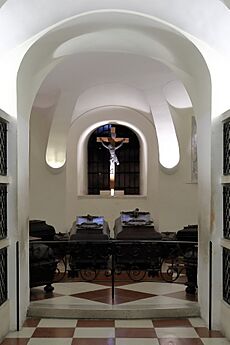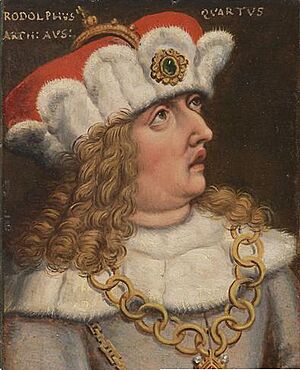Rudolf IV, Duke of Austria facts for kids
Quick facts for kids Rudolf IV |
|
|---|---|

The first half-frontal portrait of the Occident. It had been on display above Rudolf's grave in the Stephansdom of Vienna for several decades after his death, but can now be seen in the Museum of the Roman Catholic Archdiocese of Vienna. Apart from the (invented) archducal crown, the foreshortening of which the artist did not completely master, the portrait is completely realistic. Even the duke's incipient facial palsy is shown.
|
|
| Duke of Austria | |
| Reign | 1358–1365 |
| Predecessor | Albert II |
| Successor | Albert III & Leopold III |
| Born | 1 November 1339 Vienna |
| Died | 27 July 1365 (aged 25) Milan |
| Burial | Ducal Crypt, Vienna |
| Spouse | Catherine of Luxembourg |
| House | House of Habsburg |
| Father | Albert II, Duke of Austria |
| Mother | Joanna of Pfirt |

Rudolf IV (born November 1, 1339 – died July 27, 1365) was a powerful ruler from the House of Habsburg. He was also known as Rudolf the Founder (German: der Stifter). He became the duke of Austria, Styria, and Carinthia in 1358. Later, he also ruled as the count of Tyrol from 1363 and the first duke of Carniola from 1364.
Rudolf wanted to make Austria more important. He created a special document called the "Privilegium Maius". This document was a fake, but it helped to give Austrian rulers more power.
Contents
Early Life of Rudolf IV
Rudolf was born in Vienna, the capital of Austria. He was the oldest son of Duke Albert II of Austria and Joanna of Pfirt. Rudolf was the first Habsburg duke in Austria to be born right there in the duchy. This made him feel very connected to Austria. His subjects, the people he ruled, also felt this connection, which made him popular.
Rudolf lived during the late Middle Ages. He was a very active and energetic ruler. People said that even as a young man, he seemed like a king.
Rudolf's Rule and Achievements
In 1357, Rudolf married Catherine of Bohemia. She was the daughter of Emperor Charles IV. Emperor Charles IV had made his capital, Prague, a very important cultural center. Rudolf wanted to make his own city, Vienna, just as grand.
Making Vienna a Great City
Rudolf worked hard to make Vienna a major city. He wanted it to be as important as Prague.
Expanding St. Stephen's Cathedral
For a long time, the rulers of Austria wanted Vienna to have its own diocese. A diocese is an area managed by a bishop. Vienna's main church, St. Stephen's, was under the control of bishops from another city, Passau.
Rudolf found a clever way around this. He started a special group at St. Stephen's Church. Its members wore red clothes, like cardinals. The leader of this group was called the "archchancellor of Austria." This made St. Stephen's seem more important.
Rudolf also started building the large Gothic part of St. Stephen's Cathedral. This was another way to compete with the grand St. Vitus Cathedral in Prague. He even had statues of himself and his wife placed at the cathedral's entrance.
Founding the University of Vienna
In 1365, Rudolf founded the University of Vienna. He did this to match Emperor Charles IV, who had founded the Charles University of Prague in 1348. The University of Vienna is still known as Alma Mater Rudolphina today. It is the oldest university in the German-speaking world that has been open continuously.
Improving Vienna's Economy
Rudolf also took steps to improve the economy of Vienna. He made sure that the city's mayor oversaw property sales. This helped prevent too much land from being owned by the Church, which was not always good for the economy. Rudolf also created a stable money system called the Wiener Pfennig (Vienna Penny).
The Privilegium Maius
Rudolf is most famous for a clever trick: he created the "Privilegium Maius." This was a forged, or fake, document. It claimed to give Austria special rights and powers. It made the ruler of Austria almost as powerful as the seven Prince-electors of the Holy Roman Empire. These electors were the only ones who could choose the Holy Roman Emperor.
This document helped make up for the fact that Austria did not get an electoral vote in the Golden Bull of 1356. The "Golden Bull" was a real document issued by Emperor Charles IV that set out how the emperor would be chosen.
Rudolf also invented the title of Archduke (Erzherzog). This title became a special honor for all male members of the House of Habsburg from the 16th century onwards.
Expanding Austrian Lands
In 1363, Rudolf made an agreement with Countess Margaret of Gorizia-Tyrol. This agreement meant that the County of Tyrol would become part of Austria after her death. This happened in 1369.
In 1364, Rudolf made the Carinthian region of Carniola into a duchy. The next year, he founded a new town called Novo Mesto. Its German name, Rudolfswert, was given in his honor. He also made an agreement with his father-in-law, Emperor Charles IV. This agreement said that if one ruling family died out, the other would inherit their lands.
Rudolf's Death
Rudolf had many big plans, and he managed to modernize his lands and the city of Vienna. Vienna became much more important because of his efforts.
Rudolf died suddenly in Milan in 1365, when he was only 25 years old. He and his wife are buried in the Ducal Crypt under the Stephansdom in Vienna.
His early death meant that many of his plans could not be finished. His younger brothers, Albert III and Leopold III, were supposed to rule together. But they argued and eventually divided the Habsburg lands between them in 1379.
It was Leopold's descendant, Frederick V of Austria, who later brought all the Austrian lands back together. He built on Rudolf's hard work and laid the foundation for the powerful Habsburg monarchy.
Images for kids
-
The first half-frontal portrait of the Occident. It had been on display above Rudolf's grave in the Stephansdom of Vienna for several decades after his death, but can now be seen in the Museum of the Roman Catholic Archdiocese of Vienna. Apart from the (invented) archducal crown, the foreshortening of which the artist did not completely master, the portrait is completely realistic. Even the duke's incipient facial palsy is shown.
-
The decipherment of the epitaph accompanying the cenotaph, or symbolic tomb, of Duke Rudolph IV in the Stephansdom in Vienna. The translation of the secret writing into English is "This is the sepulchre of Rudolph, by the Grace of God, Duke and Founder" and "Almighty God and great lord Jesus Christ, a shepherd." Rudolf was, in fact, never buried within the almost-solid stone structure, but in the Ducal Crypt of the Stephansdom in Vienna. The text is written using the Alphabetum Kaldeorum, a code he probably invented.







